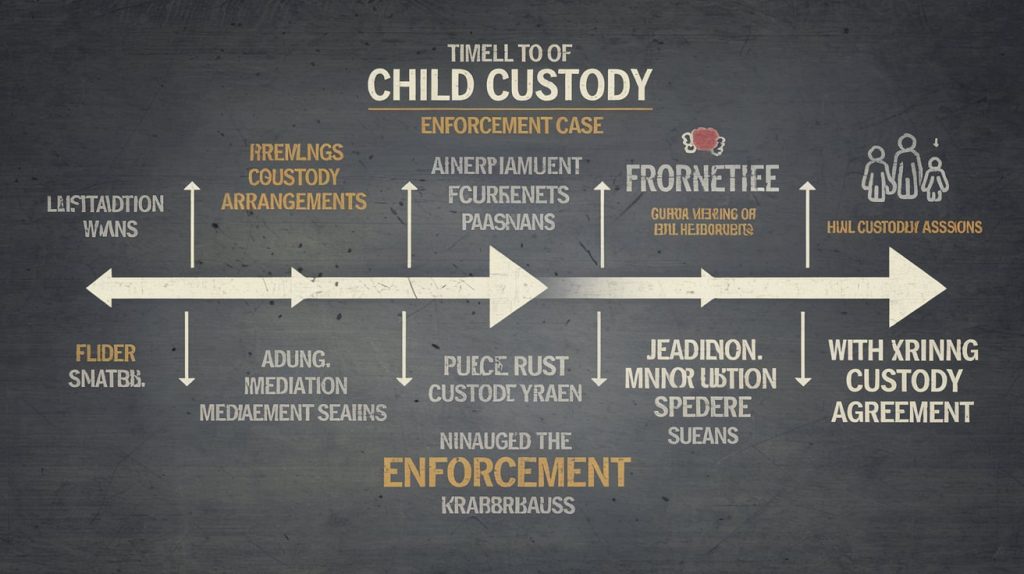When dealing with child custody issues, enforcement can be one of the most critical and challenging aspects. Parents facing custody disputes often wonder how long the enforcement process takes, what steps are involved, and how they can ensure a favorable outcome. In this guide, we will break down the child custody enforcement timeline in the US, outlining key steps and providing practical advice to help you navigate this complex legal process.
What is Child Custody Enforcement?
Child custody enforcement refers to the legal process of ensuring that court-ordered custody arrangements are followed. This becomes necessary when one parent violates the custody agreement by withholding visitation, moving the child without permission, or refusing to comply with other aspects of the court order.
Courts take these violations seriously, as the primary goal is to prioritize the best interests of the child. Understanding the enforcement process is essential to ensuring compliance and maintaining stability for your child.
Key Steps in the Child Custody Enforcement Process
- Identifying a Violation
- The first step in enforcement is recognizing that a violation has occurred. Common violations include:
- Denying court-ordered visitation rights.
- Failing to return the child after visitation.
- Making significant decisions about the child without consulting the other parent, contrary to the custody agreement.
- The first step in enforcement is recognizing that a violation has occurred. Common violations include:
- Gathering Evidence
- Document the violation thoroughly. This could include:
- Text messages or emails showing refusal of visitation.
- Witness accounts of missed exchanges.
- Logs or calendars noting repeated violations.
- Document the violation thoroughly. This could include:
- Filing a Motion for Enforcement
- To initiate the enforcement process, file a motion with the court. This motion should include:
- Details of the custody order.
- Evidence of the violation.
- A request for specific remedies, such as fines, make-up visitation, or modification of the custody agreement.
- To initiate the enforcement process, file a motion with the court. This motion should include:
- Court Hearing
- After filing the motion, a court hearing will be scheduled. Both parties will present their case, and the judge will determine if a violation occurred and decide on appropriate remedies.
- Remedies and Penalties
- If the court finds that the custody order was violated, possible outcomes include:
- Enforcement of the existing custody order.
- Modifications to the custody arrangement.
- Financial penalties for the violating parent.
- In extreme cases, contempt of court charges.
- If the court finds that the custody order was violated, possible outcomes include:
Timeline for Child Custody Enforcement
The timeline for enforcement can vary depending on the complexity of the case and the court’s schedule. On average, the process can take anywhere from a few weeks to several months. Factors influencing the timeline include:
- The severity of the violation: Urgent violations, such as parental abduction, are typically expedited.
- Availability of evidence: Well-documented cases tend to progress faster.
- Court backlog: Some jurisdictions experience delays due to high case volumes.
How Mediation and Arbitration Can Help
Before resorting to court enforcement, many parents explore alternative dispute resolution methods, such as:
- Mediation: A neutral third party helps both parents reach an agreement without going to court. Mediation can be faster and less adversarial than litigation.
- Arbitration: An arbitrator hears both sides and makes a binding decision. This option is typically faster than a traditional court process.
While these methods may not work in every situation, they can save time and reduce stress in less contentious cases.
Tips for Parents During the Enforcement Process
- Stay Calm and Composed
- Emotional outbursts can work against you in court. Focus on presenting factual evidence and prioritizing your child’s best interests.
- Seek Legal Assistance
- Hiring a family law attorney can help you navigate the complexities of enforcement and increase your chances of a favorable outcome. Explore legal options for child custody issues in the US.
- Maintain Detailed Records
- Keeping a log of violations, communication, and any related expenses can strengthen your case in court.
- Put Your Child First
- Avoid involving your child in disputes or speaking negatively about the other parent in front of them. Courts prioritize the emotional well-being of the child.
Internal Resources for Further Guidance
- How to File a Child Custody Motion: A step-by-step guide for initiating custody-related court actions.
Final Thoughts
Child custody enforcement can be a stressful and emotional process, but understanding the timeline and key steps can help you navigate it with confidence. Whether through court intervention or alternative dispute resolution, prioritizing your child’s well-being should always be the guiding principle.
For more insights and legal advice, explore our comprehensive resources on ApnaQanoon. If you’re dealing with a custody dispute, don’t hesitate to seek professional assistance to ensure a smooth and fair resolution.

